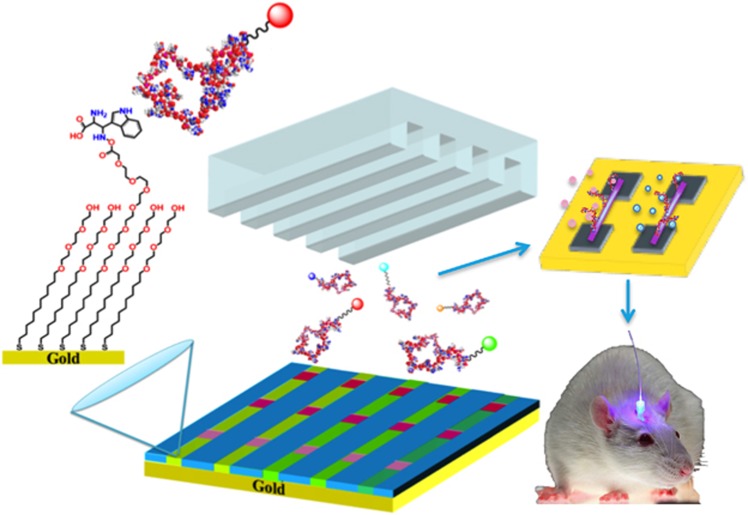The demand for new strategies to combat debilitating psychiatric and neurodegenerative diseases necessitates revolutionizing our approaches to investigate the connectivity and function of neural circuits. To elucidate how alterations in neuronal networks, which function at nanoscale synapses, contribute to brain-related disorders, it will be essential to monitor chemical neurotransmission in vivo at the length and timescales pertinent to intrinsically encoded information (Andrews, 2013). Nonetheless, current approaches for sensing neurotransmitters are far removed from these scales needed to decode chemical information processing in neurocircuitry.
To address the challenges of designing ultra-small, fast, highly selective, and multiplexed biosensors, we are investigating aptamers, which have emerged as alternatives to antibodies for molecular recognition. Aptamers are synthetic single-stranded DNA or RNA sequences that fold into unique three-dimensional structures to effect specific interactions with binding targets. Yet despite their promise, the elucidation of these rare nucleotide sequences is impeded by difficulties associated with producing screening substrates having highly controlled surface chemistries and characteristics (Vaish et al, 2010). Aptamers with picomolar to femtomolar dissociation constants exist but they are limited to sequences that recognize molecules significantly larger than neurotransmitters. To unleash the full potential of aptamers for in vivo neurotransmitter biosensing, we have invested a decade of research aimed at developing materials that enable high-affinity interactions between neurotransmitters tethered to optimized biospecific surfaces and nucleic acid libraries.
These substrates, termed ‘neurochips', are fabricated so as to create enhanced environments for molecular recognition by controlling essential parameters and reducing nonspecific binding (Figure 1). Neurochips selectively capture large biomolecule binding partners including antibodies, native G-protein-coupled receptors (Vaish et al, 2010), and nucleic acid aptamers. At present, we are using neurochips to identify rare nucleotides isolated from combinatorial libraries consisting of hundreds of billions of candidate sequences based on relative affinities for small-molecule neurotransmitter targets. We have also developed micro- to nanoscale surface patterning techniques (Liao et al, 2012) and used high-throughput microfluidics (Liao et al, 2013) to create multiplexed neurotransmitter substrates. A significant advantage of multiplexed patterning is the capacity to capture and to sort different neurotransmitter-specific aptamers side-by-side while providing opportunities to determine and to compare in situ binding affinities.
Figure 1.
Schematic (not to scale) showing the chemistry, patterning, and use of neurochips to identify rare nucleotide sequences (aptamers) for use as neurotransmitter recognition elements in novel sensing devices to monitor chemical neurotransmission. (Left) The chemistry of self-assembled alkanethiols on gold substrates is shown. A small percent of these molecules is functionalized with 5-hydroxytryptophan (or other precursors/amino acids) to mimic free serotonin (or other neurotransmitters). (Middle) A neurochip patterned orthogonally via a microfluidics device is shown. This type of neurochip is used to screen large libraries of chemically synthesized nucleic acids to identify aptamer sequences that selectively recognize neurotransmitters. (Right) Aptamers are coupled to nanowire field-effect transistor devices for brain implantation and high-resolution in vivo neurotransmitter sensing.
The discovery of neurotransmitter aptamers will enable their functional integration into nanometer-diameter field-effect transistor (FET) nanowires, which will function as neurotransmitter recording elements (Figure 1). Devices patterned with aptamer-modified FETs will be used to carry out dynamic in vivo monitoring of neurotransmission with response times on the order of milliseconds (or faster) (Kim et al, 2015). When combined with appropriate passivation to suppress biofouling, microsensors that detect dopamine with sub-second temporal resolution have been shown to function over months in vivo in rats and mice (Clark et al, 2010). Thus, neurochips will enable the development of devices that will advance the understanding of the roles of small-molecule neurotransmitters in the complex landscape of brain interneuronal communication and dysfunction. Unraveling the emergent properties of integrated chemical neurotransmission associated with neural circuits using this approach will be advantageous for uncovering processes associated with cognition, emotion, and learning and memory.
FUNDING AND DISCLOSURE
During the past 3 years, AMA has received compensation from Forest Laboratories (Actavis) for work as a consultant and from the American Chemical Society for work as Associate Editor of ACS Chemical Neuroscience, in addition to income from her primary employer (University of California, Los Angeles). NN declares that, except for graduate student stipends received from the University of California, Los Angeles, no financial support or compensation has been received from any individual or corporate entity over the past three years for research or professional service, and there are no personal financial holdings that could be perceived as constituting a potential conflict of interest.
Acknowledgments
Funding from the CalBRAIN Neurotechnology Program and the Shirley and Stefan Hatos Foundation are gratefully acknowledged.
References
- Andrews AM (2013). The BRAIN initiative: toward a chemical connectome. ACS Chem Neurosci 4: 645. [DOI] [PMC free article] [PubMed] [Google Scholar]
- Clark JJ, Sandberg SG, Wanat MJ, Gan JO, Horne EA, Hart AS et al (2010). Chronic microsensors for longitudinal, subsecond dopamine detection in behaving animals. Nat Methods 7: 126–129. [DOI] [PMC free article] [PubMed] [Google Scholar]
- Kim J, Rim YS, Chen H, Cao HH, Nakatsuka N, Hinton HL et al (2015). Fabrication of high-performance ultrathin In2O3 film field-effect transistors and biosensors using chemical lift-off lithography. ACS Nano 9: 4572–4582. [DOI] [PubMed] [Google Scholar]
- Liao WS, Cao HH, Cheunkar S, Shuster MJ, Altieri SC, Weiss PS et al (2013). Small-molecule arrays for sorting G-protein-coupled receptors. J Phys Chem C 117: 22362–22368. [Google Scholar]
- Liao WS, Cheunkar S, Cao HH, Bednar HR, Weiss PS, Andrews AM (2012). Subtractive patterning via chemical lift-off lithography. Science 337: 1517–1521. [DOI] [PubMed] [Google Scholar]
- Vaish A, Shuster MJ, Cheunkar S, Singh YS, Weiss PS, Andrews AM (2010). Native serotonin membrane receptors recognize 5-hydroxytryptophan-functionalized substrates: enabling small-molecule recognition. ACS Chem Neurosci 1: 495–504. [DOI] [PMC free article] [PubMed] [Google Scholar]



